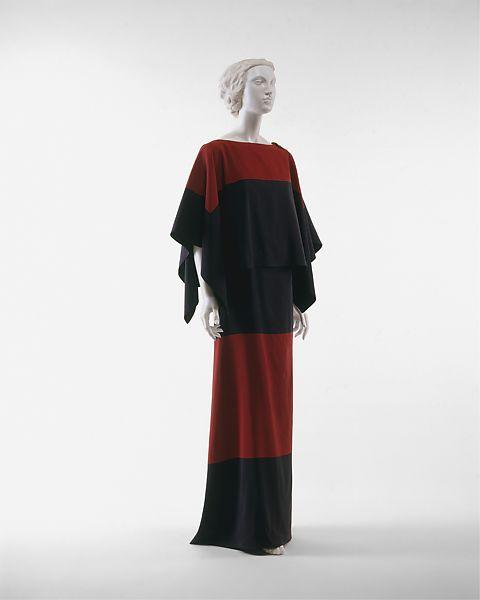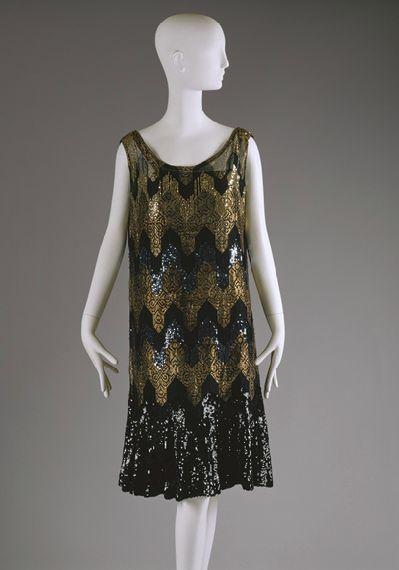Various fashion trends have always been a significant part of the things that make each era or century unique and easily recognizable. This essay will touch upon the fashion choices of the 20th century, particularly with regard to renowned designers who created a legacy. In this paper, an evening dress by Paul Poiret and an evening dress attributed to Gabrielle Chanel will be compared and contrasted.
Poiret’s dress (figure 1) was crafted in France, years 1922-1923. Born in 1879, Paul Poiret had been gradually achieving his fame since 1898 when a famous couturier took interest in his collections. However, for Poiret, it was the 1910s that became the decade in which fashion trends were shaped and dictated by him. (Koda, Bolton, 2008). In 1901, having finished his military service, Poiret was invited to work for the house of Worth. Although he had gained recognition due to his nightgowns, his purpose at Worth was creating a comfortable practical clothes for women to wear every day. (“Paul Poiret”, n. d.). This job helped Poiret understand the preferences of women for a daily outfit better and it might be exactly what prompted his future influence on the world of fashion.
Poiret’s first steps in the fashion industry were to make female bodies free from the restrictions of corsets and petticoats. Even though he was not the only designer trying to achieve this goal, he is the one now heavily associated with the new type of silhouette. Thus, his evening dress (figure 1) is an instance of such silhouette. It is a high-waisted uncorseted garment that consists of two separate pieces – a top and a long cylindrical skirt, but the impression it creates is that of a one-piece gown. Furthermore, this impression along with Poiret’s aspiration for the liberation of the body makes this evening dress resemble a modern variation of a peplos. Normally, a peplos is crafted out of a single piece of clothing. (Koda, 2003) However, the way it drapes around the body and forms a cylindrical shape is similar to Poiret’s gown in question (figure 1).
Both of the pieces of Poiret’s evening dress (figure 1) were tailored out of silk. The color palette of the dress consists of red and black that create a bold outstanding look appropriate for an evening occasion, such as going to a theater or visiting a party. Poiret’s designs were immensely popular among wealthy young women who searched for unique outfits and this nightgown would not be an exception, even though its fame declined in the 1920s.
Moving on to the second piece of clothing, it is an evening dress attributed to Gabrielle Chanel (figure 2). Just as the dress by Paul Poiret (figure 1), this one was created in the 1920s, specifically 1926-1927, supposedly by Gabrielle Chanel. Known under the nickname “Coco”, she was one of the most influential people in the fashion industry of the 20th century, having invented numerous trends. She was born in 1883 in Saumur in a poor family and could only open her first shops in Paris and Deauville with the help of a wealthy admirer. However, even then she had to resort to the usage of jerseys in her designs since the fabric was rather cheap. (Krick, 2004). Later, when Chanel was already prosperous in the fashion industry, she could afford more expensive materials.
Thus, the evening dress in question (figure 2) was tailored from silk with metallic lace and sequins. Now, it is widely known that Gabrielle Chanel made a revolution in the world of fashion due to the fact that she shifted the public’s attention from ultra-feminine outfits to simpler, more practical clothes. She often even took inspiration for her designs from menswear and adapted them into styles for independent women. (“Gabrielle Chanel”, n. d.). Nevertheless, decorative elements and lace were quite often used in her garments to make them more romantic and elegant. (Krick, 2004). Her gown (figure 2) is an instance of using additional ornamental elements for this purpose.
Apart from that, another prominent trait of Chanel’s gowns is their long slimline, resembling her own figure. It was a part of her concept of a “little black dress” – Chanel’s successful attempt to make women, mourning after the war, fashionable instead of devastated, and other evening dresses’ designs. (McDowell, 2015). This dress (figure 2) is a short, high-waisted, slim garment, simple and practical. The color palette is just as basic, including black and beige-brown, which are known to be Chanel’s favorite shades. In the 1920s young women striving to become more independent in their fashion choices could be wearing this gown to various evening occasions.
Comparing the two garments, similarities, as well as differences, can be singled out. Both of them are evening dresses from the same decade that were crafted using the same medium – silk. However, unlike Poiret’s gown (figure 1), Chanel’s dress (figure 2) includes additional decorative elements, namely sequins and metallic lace. At the same time, Poiret’s design (figure 1), although not heavy on decorative details, is a two-piece gown, as opposed to Chanel’s simple one-piece fashion (figure 2). Both designs are high-waisted and uncorseted, which was the new trend of the 20th century, but their overall appearances differ significantly. While Chanel’s one-piece gown (figure 2) is a long slim silhouette, Poiret’s garment (figure 1) resembles a Greek peplos due to the way it drapes around the body, giving the skirt a cylindrical shape. Finally, the color palette of Poiret’s dress (figure 1) is bolder and more vivid, mixing red with black, whereas Chanel’s gown (figure 2) is a simple combination of black and beige.

- Designer: Paul Poiret
- Title: Evening dress
- Date: 1922-1923
- Materials: Silk
- Museum Accession Number: C.I.43.85.2a, b

- Designer: Attributed to Gabrielle Chanel
- Title: Evening dress
- Date: 1926-1927
- Materials: Silk, metallic thread, sequin
- Museum Accession Number: C.I.65.47.2a, b
References
Gabrielle Chanel. (n. d.). The Museum at FIT. 2020,Web.
Koda, H. (2003). The chiton, peplos, and himation in modern dress. The Metropolitan Museum of Art. Web.
Koda, H., & Bolton, A. (2008). Paul Poiret (1879-1944). The Metropolitan Museum of Art. Web.
Krick, J. (2004). Gabrielle “Coco” Chanel (1883-1971) and the House of Chanel. The Metropolitan Museum of Art. Web.
McDowell, C. (2015). Gabrielle “Coco” Chanel (1883-1971). BoF – The Business of Fashion. Web.
Paul Poiret. (n. d.). The Museum at FIT. 2020, Web.